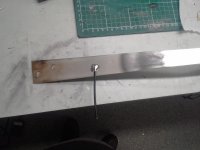jonescg
100 MW
Something which was discussed at length a long time ago, especially when folks were buying A123 pouch cells, was the issue of how to terminate them. Soldering has long been a popular way of terminating pouch cells in the RC world, but that's because the tabs are usually copper - either nickel or tin plated - and on the (+) terminal which is almost always aluminium, it's ultrasonically welded to the cathode stack.
Well in the end mechanical terminations (screws and nuts) and ultrasonic bonding proved to be the winner, but prompted by some clever re-working of Tesla packs, I learned that folks were soldering directly to the aluminium busplates of the Tesla modules.
Turned out the aluminium was nickel-plated, and once this is done, you can solder to it directly provided the surface is clean and the iron is hot enough.
So we had some aluminium nickel plated and we soldered to it directly. I don't know if this is of much use to anyone these days, but it's a pretty nice feature if you were that way inclined. They need to clean the Al, then acid etch it, then apply a zinc coating, and the nickel is electroplated by means of a nickel sulfamate solution. The finish is a slightly dull, light grey but there are decorative ways of finishing it nicely.

Well in the end mechanical terminations (screws and nuts) and ultrasonic bonding proved to be the winner, but prompted by some clever re-working of Tesla packs, I learned that folks were soldering directly to the aluminium busplates of the Tesla modules.
Turned out the aluminium was nickel-plated, and once this is done, you can solder to it directly provided the surface is clean and the iron is hot enough.
So we had some aluminium nickel plated and we soldered to it directly. I don't know if this is of much use to anyone these days, but it's a pretty nice feature if you were that way inclined. They need to clean the Al, then acid etch it, then apply a zinc coating, and the nickel is electroplated by means of a nickel sulfamate solution. The finish is a slightly dull, light grey but there are decorative ways of finishing it nicely.


